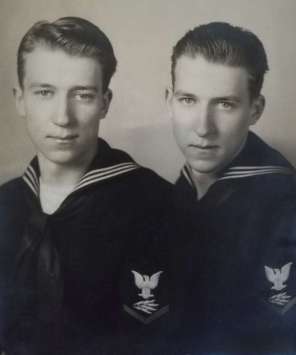
Julius (pictured left), born of German immigrant parents, worked together with his twin, Louie, for Burlington Railroad and enlisted together with him in the Navy. Both were radio operators and both were on the same unwieldy flat-bottom boat, Landing Ship Tank Number 523 (LST-523), making the Channel crossing from Falmouth, England, to Utah Beach 13 days after the June 6 D-Day landings.
The LST-523 mission was to deliver supplies at the Normandy beachhead and remove the wounded. It never got there.
The vessel struck an underwater mine and sank off the coast. Of the 145 Navy crew members, 117 were found perished. Survivors’ accounts speak of a major storm on the Channel with pitched waves that tossed the boat mercilessly before the explosion that shattered the vessel.
While his brother Louie’s body was soon found, identified and laid to rest, Julius’ remains were only recovered in 1961 by French salvage divers who found them in the vessel’s radio room. He was interred as an “Unknown” at the Ardennes American Cemetery in Neuville, Belgium, also devoted to the fallen of World War II, in the region that saw the bloody Battle of the Bulge.
Julius’ remains might have stayed among those of 13 other troops from the doomed LST-523 still resting unidentified at the Ardennes cemetery. But in 2017, a U.S. agency that tracks missing combatants using witness accounts and DNA testing identified him.
The Pieper family asked that Louie’s grave in Normandy be relocated to make room for his twin brother at his side.
“They are finally together again, side by side, where they should be,” said their niece, Susan Lawrence, 56, of California.
We honor you, Julius Pieper.
